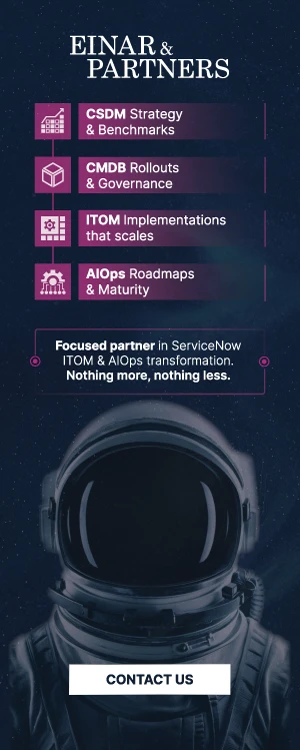
Las Vegas hosted this year’s Knowledge 2025 – an event focused on the practical realities of AI, automation, and platform evolution, and their growing role in how organisations operate and deliver value. Yet behind the headline themes, a different, deeper story was being told. At Einar & Partners, our focus was not only on what was being promoted, but on what truly resonated across sessions and side discussions alike. Again and again, one message stood out: Governance is the new frontier.
Moving past the AI conversation
AI took center stage across keynotes, roadmaps, and product sessions. The vision was clear: an intelligent platform, driven by agentic AI, capable of taking autonomous actions and driving outcomes. It’s an ambitious, promising vision. But despite the enthusiasm, many attendees were quietly asking a different set of questions – less about potential and more about readiness.
A consistent thread emerged: before AI can drive value, the fundamentals must be in place. That means accurate, well-structured data, aligned ownership, and clear governance. Since organisations today still struggle to govern their digital environments, they are starting to recognise that without these basics, advanced automation simply amplifies existing problems.
The focus, then, is shifting from what AI can do, to what’s required to use it responsibly and effectively. In other words: visibility, ownership, role clarity, and lifecycle alignment. These are the pillars that support any meaningful transformation; AI-powered or otherwise.
Strategic Portfolio Management and Architecture take the lead
One of the most significant signals from this year’s event was the clear momentum behind strategic portfolio management (SPM) and enterprise architecture (EA). These practices, once seen as high-level planning functions, are now central to aligning technology with business strategy.
With the release of CSDM 5, ServiceNow formalised this change and the narrative has therefore shifted from technology as support function to technology as the business itself. The updated model introduces full lifecycle support – from ideation and strategy, through to delivery and consumption. In short, organisations now have a framework to connect business goals with the platforms and services that enable them.
Simply put, organisations are realising that:
- Governance is no longer optional.
- EA is the new entry point for transformation.
- Without portfolio oversight, even the best tooling leads to chaos.
The future isn’t just digital. It’s strategically digital, and that requires connecting business strategy to operational execution across the full service lifecycle
This development wasn’t just theoretical. In conversations and sessions, it became evident that more teams are starting at the architecture level, using EA practices to guide service planning, investment prioritisation, and platform design. Rather than working backwards from tools, the trend is to work forward from business value.

Governance is not a tool, it’s an operating model
Throughout the conference, governance came up again and again – not as a checkbox, but as a challenge still largely unresolved. While tooling has matured, the structures, roles, and responsibilities that enable effective governance remain inconsistent.
Discussions with financial institutions, government agencies, and global enterprises highlighted the same barriers: they reached technical maturity before governance maturity, and are now backtracking to establish what should have been foundational from the start.
For example, Paypal initiated their CMDB journey primarily to meet regulatory standards like DORA, but quickly encountered fundamental challenges:
- Data ownership confusion
- Process fragility
- Tool over-customisation
- Poor governance maturity
And they’re not alone. From global banks to federal agencies, the message was the same: everyone is trying to implement governance, but few have a roadmap. In short, the technology is there, but the operating model is catching up.
This is where frameworks like CSDM and EA become not just useful, but essential. They offer the scaffolding to finally bring order, consistency, and confidence to chaotic digital estates.
Why this matters now
Governance is gaining traction for three important reasons:
- The pressure to demonstrate real business value from platforms and services – not just delivery, but outcomes.
- Rising regulatory requirements, such as DORA and NIS2, which demand transparency, traceability, and risk control.
- The limitations of AI without structured environments, leading teams to realise that governance isn’t an option, it’s a precondition.
Governance is no longer just about maintaining data. It’s about defining roles, responsibilities, and decision rights across business and IT. Organisations must know what they have, who owns it, and how it’s used in order to scale, adapt, and deliver consistently. And this is not just IT’s job anymore. It’s a business imperative.
Connecting business and operations: The path forward
At Einar & Partners, we’ve long believed that the CMDB is more than an inventory: it’s a strategic decision engine. That belief was echoed at Knowledge 2025.
We’re also seeing a shift in client conversations, from feature-focused implementations to value stream alignment, platform governance, and shared accountability models. Looking ahead, the most successful organisations will be those that intentionally bridge business and operational planning.
As we prepare for our upcoming ITOM & AIOps Trends Shaping the Future event in Luxembourg, these insights drive everything; from our event agenda to how we speak about CMDB, governance, and digital services. We’re advocating for a model that merges enterprise architecture, service portfolio management, and operational excellence, with governance at its core. Our message is simple: it’s time to treat technology not just as a delivery mechanism, but as part of the business itself.
Final thoughts: Are you ready?
AI is here. But behind every intelligent agent, there’s a real question: Are you ready to govern what it relies on?
Technology is no longer something we use. It’s how we operate, how we innovate, and how we compete. That means governance is no longer a back-office concern – it’s the foundation of digital success.
If you’re interested in learning more, continue exploring our Research Unit website, or visit our Youtube & LinkedIn channels. We’re also hosting a dedicated event in Luxembourg where these topics will be explored in depth – bringing together experts and practitioners for practical discussions on what’s next!








